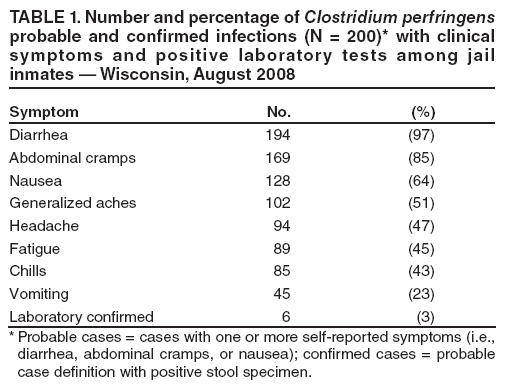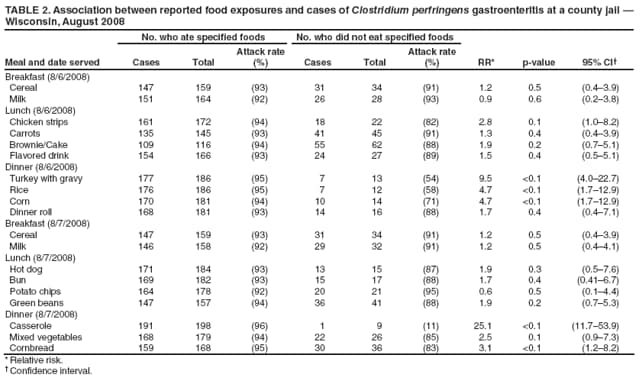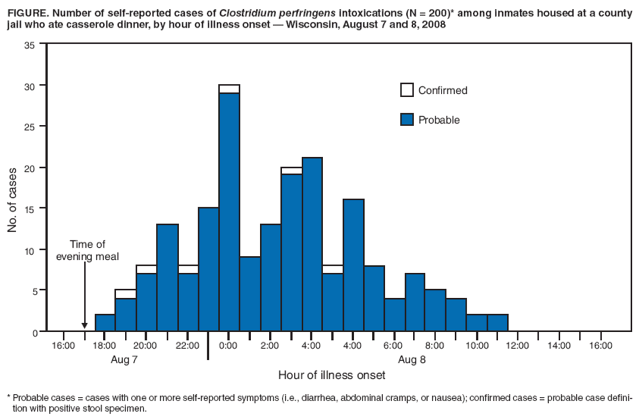 |
|
|
|
|
|
|
| ||||||||||
|
|
|
|
|
|
|
||||
| ||||||||||
|
|
|
|
|
Persons using assistive technology might not be able to fully access information in this file. For assistance, please send e-mail to: mmwrq@cdc.gov. Type 508 Accommodation and the title of the report in the subject line of e-mail. Clostridium perfringens Infection Among Inmates at a County Jail --- Wisconsin, August 2008Please note: Errata have been published for this article. To view the errata, please click here and here. On August 8, 2008, employees at a Wisconsin county jail noted nausea, vomiting, and diarrhea among more than 100 inmates during the early morning inspection. Seven inmates were seen by the jail nurse that morning. Following jail protocol, guards gave at least 60 inmates bismuth subsalicylate to relieve symptoms, and the jail nurse notified local health department staff members, who suspected a foodborne outbreak at the jail and initiated an investigation. This report summarizes the findings of an investigation by the Wisconsin Division of Public Health (WDPH) and the local health department, which determined the outbreak was caused by eating casserole containing ground turkey and beef (relative risk [RR] = 25.1) that was served during the evening meal on August 7. Clostridium perfringens enterotoxin was detected in stool samples collected from six ill inmates, and 43,000 CFU/g of the organism were isolated from a remaining sample of casserole. An environmental investigation determined the casserole was made with food items that were prepared and stored improperly. Proper food preparation and storage methods are especially important in large institutions such as jails and prisons, where large amounts of foods are prepared and served at one time. The county jail has a capacity of approximately 550 inmates and is regulated by the local sheriff's department. The jail houses a mixed population that includes male (approximately 90% of the population) and female adults, work release inmates, contract prisoners from the Wisconsin Department of Corrections, and juveniles housed in the juvenile detention facility. Food preparation is conducted on-site in a central kitchen. An independent food-handling company is responsible for establishing the menu, providing the food ingredients, and overseeing the food preparations, which are conducted by inmates on a weekly rotating kitchen assignment. Meals are pre-portioned and served to the inmates, to be consumed in their cells. Inmates are served a set menu and are not given a choice of food items. On August 8, 2008, after discussion with the jail nurse, WDPH epidemiologists prepared a questionnaire to record inmate demographic information, clinical signs and symptoms, time of symptom onset, and food-consumption histories for all meals served at the jail on August 6 and 7. The questionnaire was distributed to all of the inmates in their cells. All inmates, whether or not they had been ill, were asked to complete the questionnaire on August 8. Of 475 inmates at the jail on August 8, 257 (54%) returned the self-administered survey. A probable C. perfringens intoxication case was defined as the self-reported (by questionnaire) presence of at least one of the following symptoms: diarrhea (three or more loose stools in a 24-hour period), abdominal cramps, or nausea occurring between 5:00 p.m. on August 7 and 5:00 p.m. on August 8. A confirmed case was defined as a probable case with a stool sample positive for C. perfringens enterotoxin. Among the 257 inmates who answered the questionnaire, 37 returned forms that were incomplete and could not be used for analysis. Among the 220 inmates who completed the full survey, 194 probable and six confirmed cases were identified. Among those 200 cases, the most frequently reported signs and symptoms included diarrhea (97%), abdominal cramps (85%), nausea (64%), and generalized aches (51%) (Table 1). In a comment space on the questionnaire, four respondents commented on the unusual taste of the casserole. Among the 200 cases, 172 (86%) occurred in males aged 15--62 years (median: 28 years); the mean onset interval was approximately 8 hours after the August 7 evening meal (Figure). One case occurred in an inmate who was assigned to food preparation duty. None of the food preparation supervisors reported being ill, although they also consumed the meal. No information was collected on the location of ill inmates within the jail. In a cohort analysis, among food and beverages reported consumed by the inmates, the strongest association with illness was eating casserole (RR = 25.1) at dinner on August 7 (Table 2). Among 220 inmates, 192 (87%) reported eating the casserole, which was made with macaroni noodles, ground beef, and ground turkey (but not turkey served for the evening meal on August 6), frozen mixed vegetables, and gravy. Stool specimens obtained from six symptomatic inmates on August 8 were submitted to the Wisconsin State Laboratory of Hygiene (WSLH) for testing for C. perfringens and Bacillus cereus enterotoxin. On August 13, test results confirmed the presence of C. perfringens enterotoxin in stool samples from all six inmates. Tests were negative for B. cereus enterotoxin, and cultures for the outbreak stool screen for Salmonella, Shigella, Campylobcater, and Escherichia coli O157:H7 were negative. The company that distributes food to the jail routinely freezes and stores for up to 72 hours leftover food that is not served. Samples of the stored casserole, served as the main course for evening meal on August 7, were tested on August 12 for the presence of C. perfringens by the Wisconsin Department of Agriculture, Trade and Consumer Protection (DATCP), Bureau of Laboratory Services. No other food items were tested; 43,000 CFU/g (quantified via a dilution plate count) of C. perfringens was isolated from the sample of casserole. On August 8, the environmental health sanitarian from the local health department met with jail kitchen supervisors and employees of the food distribution company to assess food preparation and employee health and hygiene practices. The macaroni and ground beef in the implicated casserole were cooked the day before. The sanitarian determined that food temperatures had not been obtained or recorded consistently, and documentation of cooling temperatures for both the ground beef and macaroni, where cooling from 70°F to 41°F (39°C to 23°C) is a vital step, could not be provided. An inspection of the cooler revealed improper handling and cooling of taco meat, which was being prepared for a future meal and was not implicated in this outbreak; some containers of meat were cooled with ice paddles and other containers were not. The sanitarian recommended training kitchen employees on proper cooling processes and food history documentation requirements, stressed that reuse of food items should occur only when records of proper preparation and temperature documentation are available, and provided fact sheets on proper food-handling and preparation. Reported by: H Hsieh, MS, Outagamie County Public Health Div; J Archer, MS, R Heffernan, MPH, JP Davis, MD, Wisconsin Div of Public Health. CF Nielsen, PhD, EIS Officer, CDC. Editorial Note:C. perfringens is a ubiquitous, spore-forming bacterium and a natural inhabitant of soil and the intestinal tracts of many warm-blooded mammals, including humans. C. perfringens food contamination is a common source of foodborne illness in industrialized nations and causes an estimated 250,000 cases of diarrhea annually in the United States (1). When food products contaminated with C. perfringens are cooled too slowly or are reheated insufficiently, enterotoxin-producing vegetative cells can increase rapidly during the period when ambient temperatures range between 104°F and 122°F (40°C and 50°C). Illness is caused by the production of enterotoxin in the small intestine after ingestion of food containing e106 CFU/g of C. perfringens vegetative cells (2,3). Typical symptoms of acute abdominal pain, nausea, and diarrhea occur 6--24 hours after eating contaminated food, are generally self-limited and last approximately 24 hours; associated deaths are rare (2). Proper preparation and storage of food and cleaning and disinfection of preparation areas can effectively control foodborne illness caused by C. perfringens. The epidemiologic and laboratory results from this investigation strongly implicated the casserole as the source of illness. Consumption of casserole at the evening meal on August 7 was associated with a high risk for illness. Consumption of certain items at the evening meal on the previous day was more weakly associated with illness. However, time from consumption of these items to the onset of illness makes these items unlikely as vehicles for illness caused by C. perfringens, which has a shorter incubation period. Leftover items from the evening dinner on August 6 were not included in the casserole, nor were they available for microbiologic testing. Some cases in this outbreak occurred only a few hours after consumption of casserole, somewhat earlier than might be expected for C. perfringens. This might reflect time-reporting errors, because inmates at the jail do not have clocks or watches available in their cells. However, lower gastrointestinal symptoms can occur as soon as 2 hours after ingestion of foods containing C. perfringens (4). Laboratory detection of C. perfringens during foodborne outbreak investigations requires either quantitative cultures of implicated foods or enterotoxin-positive stool specimens from ill persons (5). In this investigation, testing of food and stool samples confirmed the presence of C. perfringens. The detection of enterotoxin in stool specimens and isolation of C. perfringens in food samples provided confirmatory evidence that C. perfringens contamination of the casserole was the causative agent for the outbreak. The casserole had been made by combining and reheating leftover food items from previous meals and food items that were near their expiration dates. The limited preparation history for these leftover foods indicated that they might not have been cooled properly after previous meals, potentially allowing C. perfringens vegetative cells to increase to concentrations sufficient to cause illness during mixing and reheating of the casserole. The food sample tested was frozen during holding and thawed before shipment. Because C. perfringens is sensitive to freezing and significant cell die-off commonly occurs when samples are frozen, the original concentration of C. perfringens cells likely was greater than 43,000 CFU/g. Foodborne outbreaks of C. perfringens infections typically occur in institutional settings, where large quantities of food are sometimes prepared several hours before serving. C. perfringens frequently has been found to contaminate meats, meat products, and gravies, and is most often associated with improper holding temperatures or inadequate cooking (2). Proper food-handling practices are imperative. Food items need to be heated before serving to temperatures sufficient to kill spore-forming bacteria, and afterward cooled quickly for storage. The optimal temperature for growth of C. perfringens vegetative cells is 109°F to 113°F (43°C to 45°C) (6,7); therefore, rapidly cooling cooked meats to below these temperatures is important (8). The findings in this report are subject to at least one limitation. The illness rate for inmates who did not submit a survey could not be determined; therefore, an overall attack rate could not be calculated reliably. Correctional workers, inmates (including those working on weekly rotations), and other persons serving as food handlers, food preparers, or food distributors should receive training and educational materials regarding food preparation as part of in-facility, pre-service training or orientation. Measures to prevent the spread of potential foodborne and waterborne pathogenic organisms should emphasize basic food and water sanitation measures and encourage good hygiene, particularly appropriate handwashing techniques, disposal of waste and soiled materials, and disinfection. Prepared foods in institutional settings should not include reused meats or other food items cooked or served with meats from previous meals unless stringent food-preparation procedures are followed, such as closely monitoring and recording cooking times and temperatures and ensuring proper cold storage and reheating. Acknowledgments The findings in this report are based, in part, on contributions by WSLH and DATCP staff members; epidemiologists, nurses, environmental health sanitarians, and other personnel of the local health department and county jail in Wisconsin; and K Bisgard, Office of Workforce and Career Development, CDC. References
Table 1  Return to top. Table 2  Return to top. Figure  Return to top.
All MMWR HTML versions of articles are electronic conversions from typeset documents. This conversion might result in character translation or format errors in the HTML version. Users are referred to the electronic PDF version (http://www.cdc.gov/mmwr) and/or the original MMWR paper copy for printable versions of official text, figures, and tables. An original paper copy of this issue can be obtained from the Superintendent of Documents, U.S. Government Printing Office (GPO), Washington, DC 20402-9371; telephone: (202) 512-1800. Contact GPO for current prices. **Questions or messages regarding errors in formatting should be addressed to mmwrq@cdc.gov.Date last reviewed: 2/19/2009 |
|||||||||
|